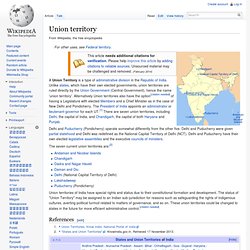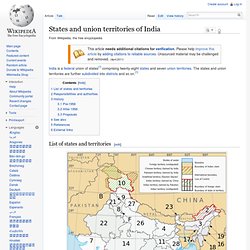

Union Territory. The seven current union territories are:[2] Union territories of India have special rights and status due to their constitutional formation and development.

The status of "Union Territory" may be assigned to an Indian sub-jurisdiction for reasons such as safeguarding the rights of indigenous cultures, averting political turmoil related to matters of governance, and so on. These union territories could be changed to states in the future for more efficient administrative control. States and territories of India. List of states and territories[edit] ^ Due to be split into two states, Telangana and a residual Andhra Pradesh on 2 June 2014.[6] Responsibilities and authorities[edit] The Constitution of India distributes the sovereign powers exercisable with respect to the territory of any State between the Union and that State.

"Article 73 broadly stated, provides that the executive power of the Union shall extend to the matters with respect to which Parliament has power to make laws. Administrative divisions of India. The Administrative divisions of India are Indian subnational administrative units; they compose a nested hierarchy of country subdivisions.

Indian states and territories frequently use different local titles for the same level of subdivision (e.g., the mandals of Andhra Pradesh correspond to tehsils of Uttar Pradesh and other Hindi-speaking states and talukas of Gujarat, Goa, Karnataka, Kerala and Tamil Nadu).[1] In the context of the Indian Constitution, local government bodies are the subject of the State List and are thereby governed by State Statutes, or in the case of Union Territories, by the Union Parliament. Federal recognition of local government was substantively expressed in the 74th Constitution Amendment Act of 1992. Zones[edit] India.